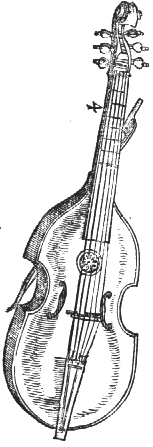Viola bastarda
The Viola bastarda is a bass - string instrument of the 16th and 17th century, similar to the viola da gamba , but with an extended body .
The term was first mentioned in a treatise by Girolamo Dalla Casa from 1584. Francesco Rognoni's doctrine of diminution Selva de varii passaggi (Milan 1620) was designed for the viola bastarda.
The contemporary composer and music researcher Michael Praetorius justifies the naming in his Syntagma musicum with the fact that the instrument “is a bastard of all voices, as it were, since it is not tied to any voice alone, but a good master of madrigals (and whatever else he uses on this instrument wants to make music) and looks for the fugues and harmony with all diligence through all voices through and through, now up on the treble , now down in the bass , now in the middle of the tenor and alto , adding cracks and ornaments and so it hurts that one can hear almost all voices in their fugues and cadences to a fair degree ”.
For the viola bastarda there are five tunings: 'D (' C) - G - c - e - a - d ',' A - E (D) - A - d - a - d ',' A - D - G - d - a - d '.
literature
- Annette Otterstedt : Article Viola da Gamba / Special Types / Viola bastarda and Division viol, in MGG Sachteil, Volume 9, Sp. 1592 and 1593.
Individual evidence
- ↑ Erich Valentin : Handbuch der Musikinstrumentenkunde. Gustav Bosse, Regensburg 1954, p. 426.
